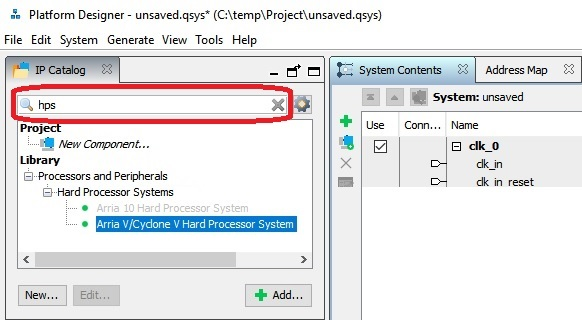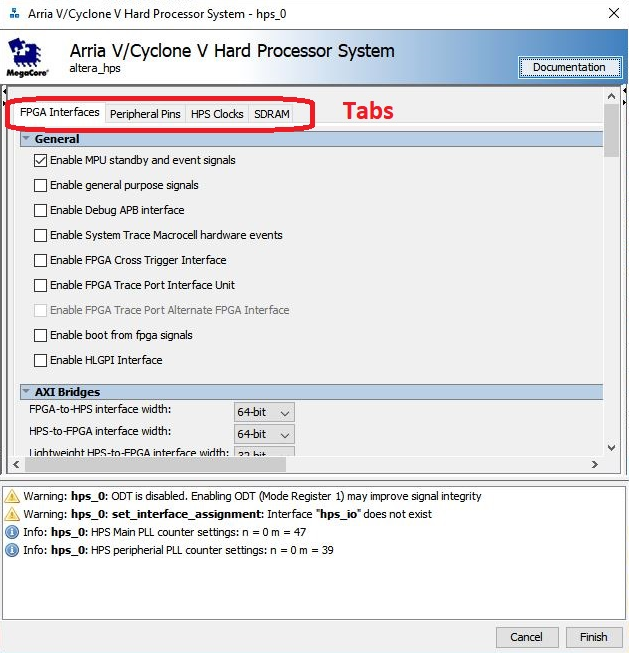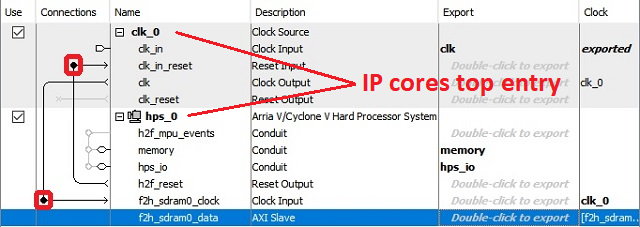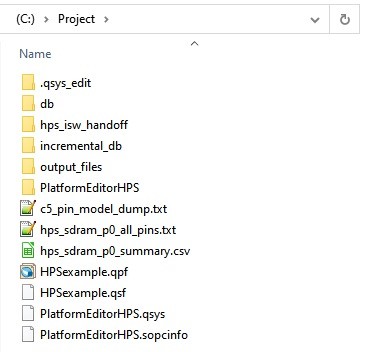Page History
...
- Click Next > in the window "EDA Tool Settings"
- Click Finish in the window "Summary"
- The Intel Quartus project is generated and the folder should look like the next figure.
System Setting
////Setup of your own project
The project wizard of Quartus lite guides through the setup of a project.
Before using it, it is suggested to create a project directory for storing it via a file browser.
Quartus lite does not create a folder for you. The generation of the bootloaders requires a
SoC EDS Shell with root privileges on a windows systems. Their file system access
is limited to the C drive. Therefore it is best practice for Windows users to store the project
on the C drive.
////
This program generates the files needed to connect and configures the HPS so that it gets connected to the physical board resources.
The basic storage resources the HPS needs are System Memory and SD card access, to communicate the basic interfaces are Uart and i²c.
These files are:
- HPSexample.sopinfo - describes all of the components and connections in your system and
parameterization of each component in the system
- PlattformEditorHPS.qip - The contains paths for all of the files for an IP core
- (hps_isw_)handoff folder - Folder containing board and SoC specific source files for generating the bootloaders
////
...
This section guides through the system setting with the Plattform Designer:
- Create a Plattform Designer file: File → New
- Select "Qsys System File" and press "OK"
- A new window should open.
- Look for "hps" inside the search field, as visible in the following figure.
- Select "Arria V/Cyclone V Hard Processor System" via double click from the tree: Library → Processors and Peripherals → Hard Processor Systems → Arria V/Cyclone V Hard Processor System
- The window "Arria V/Cyclone V Hard Processor System - hps_0" should be opened as visible in the next figure.
- In this window the HPS has to be configured with the following settings:
- Tab FPGA Interface:
- Uncheck "Enable MPU standby and event signals" (default)
AXI Bridges:
FPGA-to-HPS interface width: Unused
HPS-to-FPGA interface width: Unused
Lightweight HPS-to-FPGA interface width: Unused
- Tab Peripheral Pins:
- Quad SPI Flash Controller
- → QSPI pin: HPS I/O Set 0
- SD/MMC Controller
- → SDIO pin: HPS I/O Set 0
- → SDIO mode: 4-bit Data
- UART Controllers
- → UART0 pin: HPS I/O Set 0
- → UART0 mode: no Flow Control
- I2C Controllers
- → I2C0 pin: HPS I/O Set 1
- → I2C1 pin: HPS I/O Set 0
- Quad SPI Flash Controller
- Tab HPS Clocks:
- As is / Accept the default values (for both subtabs)
- Tab SDRAM
- Subtab Phy Settings:
- Memory clock frequency: 333.3 MHz
- PLL reference clock frequency: 25 MHz
Subtab - Memory Parameters:
Memory device speed grade: 800.0 MHz
Total interface width: 32
Row Address width: 16
Column Address width: 10
- Memory Initialization Options
Memory CAS latency setting: 5
ODT Rtt nominal value: RZQ/6
Memory write CAS latency settings: 5
- Subtab Phy Settings:
- Subtab - Memory Timing:
- tIS (base): 180 ps
- tIH (base): 140 ps
- tDS (base): 30 ps
- tDH (base): 65 ps
- tDQSQ: 100 ps
- tQH: 0.38 cycles
- tDQSCK: 225 ps
- tDQSS: 0.27 cycles
- tQSH: 0.4 cycles
- tDSH: 0.18 cycles
- tDSS: 0.18 cycles
- tINIT: 500 us
- tMRD (tMRW): 4 cycles
- tRAS: 35.0 ns
- tRCD: 13.75 ns
- tRP: 13.75 ns
- tREFI (tREFIab): 7.8 us
- tRFC (tRFCab): 350.0 ns
- tWR: 15.0 ns
- tWTR: 4 cycles
- tFAW: 40 ns
- tRRD: 12.0 ns
- tRTP: 12.0 n
Subtab - Board Settings:
Board Skews
Maximum CK delay to DIMM/device: 0.03
Maximum DQS delay to DIMM/device: 0.02
Minimum delay difference between CK and DQS: 0.09
Maximum delay difference between CK and DQS: 0.16
Maximum skew within DQS group: 0.01
Maximum skew between DQS groups: 0.08
Maximum skew within address and command bus: 0.03
- Tab FPGA Interface:
- Click "Finish" to close the window "Arria V/Cyclone V Hard Processor System - hps_0".
Add connections via clicking into the circle marked with a red rectangle in th next figure:
hps_0 - h2f_reset → clk_0 - clk_in_reset
clk_0 - clk → hps_0 - f2h_sdram0_data
- The HPS is nearly configured. Apply some auto functions:
System → Assign Base Addresses
System → Assign Interrupt Numbers
System → Assign Custom Instruction Opcodes
System → Create Global Reset Network
- Click Generate HDL... to generate the hardware description language file.
- Window "Generation" opens.
- In this window, under "Synthesis", select via dropdown menu in which Hardware Language your HDL will be created, Verilog or VHDL,
- Uncheck Create timing and resource estimate... .
- Check Create block symbole file (.bsf).
- Click Generate, as visible in the next figure.
...
- In the "Select File" window select the file ... > PlatformEditorHPS → synthesis → PlatformEditorHPS.qip.
- Click OK.
- Change the view from "Hierarchy" to "Files" inside the drop-down menu withing the "Project Navigator".
- Set file "PlatformEditorHPS.qip" as top-level entity by right clicking onto the file and selecting Set as Top-Level Entity.
- Select Tools → Tcl Scripts...
- Select Project → PlatformEditorHPS → synthesis → submodules → hps_sdram_p0_pin_assignments.tcl and click Run.
- Confirm the notification and close the previous window through Close.
- Press Processing → Start Compilation
- Compilation process has to be finished without errors. Fix errors if there are some.
- The project folder should look like the following figure.
...
Plattform Designer
This program generates the files needed to connect and configures the HPS so that it gets connected to the physical board resources.
The basic storage resources the HPS needs are System Memory and SD card access, to communicate the basic interfaces are Uart and i²c.
These files are:
- HPSexample.sopinfo - describes all of the components and connections in your system and
parameterization of each component in the system
- PlattformEditorHPS.qip - The contains paths for all of the files for an IP core
- (hps_isw_)handoff folder - Folder containing board and SoC specific source files for generating the bootloaders
...
File → New , select Qsys System File and press OK, the Plattform Designer opens in a new window.
To configure the resources and interfaces of the HPS, it needs first to be added into the system,
Type into the search field in the upper left column hps.
Select Arria V/Cyclone V Hard Processor System via double click from the tree:
Library - Processors and Peripherals - Hard Processor Systems - Arria V/Cyclone V Hard Processor System
In Project Navigator, upper left column in Quartus, use the Drop-down Menu for changing from Hierarchy to Files.
The file PlatformEditorHPS.qip is now visible and via right click onto the file, it must be Set as Top-Level Entity.
Lastly, a TCL-Script needs to be run. In Quartus click onto Tools → Tcl Scripts ... . The window - Tcl Scripts - opens, select
Project1 → PlatformEditorHPS → synthesis → submodules → hps_sdram_p0_pin_assignments.tcl , click Run to execute the script.
After the script finishes, confirm the notification and close the previous window through close.
Hit Processing → Start Compilation and wait until the compilation has finished , this must finish without any error,
warnings and critical warnings are expected.
Now the project folder contains the following.




